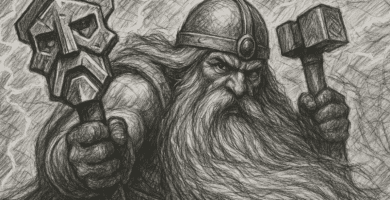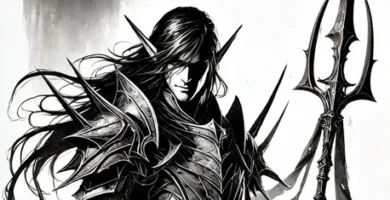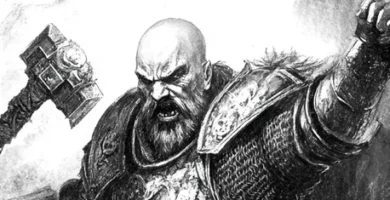Warhammer Anvil of Doom isn’t bolted to the ground… it’s just too dwarfy to want to move (yields ground, pursues…).
If you’re wondering whether to include it in your The Old World list, here I’ll explain EVERYTHING: how to deploy it, when it shines, whether it really justifies its 235 points, and a tip to avoid getting tricked by dwarf players when they use it against you.

What does the Anvil of Doom do in TOW?
It might seem like the dwarfs’ best option against magic — the most solid one. It has Magic Resistance 3 and it’s the only choice that dispels like a level 3 wizard, giving it a 24-inch range (instead of the 18 inches of the Runesmith or the 21 the Rune Lord has in version 1.5). Plus, it can carry up to 3 Spellbreaking Runes.
There’s a really important decision you must make: how you deploy it. It can’t move voluntarily, so you better place it well from the start.

Advantages of defensive deployment (at the back of the field)
- The enemy will take longer to charge it.
- Being immune to panic, it won’t flee off the board even if you place it right at the edge (only if it gives ground).
- You can protect it with a unit in front, making it physically impossible for the enemy to charge (their base won’t fit).
- It’s harder for the enemy wizard to dispel its spells.
- Although it needs line of sight for the magic missile, it can still see large targets (although usually wounding on 6+, not ideal).
- You can cast the buff spells easily even through your own troops because its frontal arc is 360°.
Disadvantages:
- It’s farther away to dispel enemy spells.
- Easier for the enemy to avoid having juicy targets in its missile range or line of sight.
- Less protected against enemy ambushers.
- Now in version 1.5, your army generally needs to be more mobile in order to score secondary objectives — you can’t just play the “come at me” game anymore, and chances are your whole army won’t stay within that 24″ range to get buffed.
Advantages of aggressive deployment (in line with your battleline)
Most likely, after the 1.5 rules update, the introduction of new scenarios and missions, and the resulting shift in the meta, this will become the most common approach
- Makes it harder for enemy wizards to move out of your dispel range.
- Better line of sight to launch the 27” magic missile.
- You can use Spellbreaking Runes with 24″ range if the Anvil carries them.
- The Anvil of Doom is tough (Toughness 7, 5 wounds, ward save 5+) and can provide cover to other units.
- In combat, it’s immune to panic and has 5 attacks… it’s not something a Great Eagle or a pack of Furies will easily take out with a turn 2 charge.
- Much better protected against enemy ambushers.
Disadvantages:
- Easier for the enemy to charge you (and even if they don’t kill it, if it’s in close combat, it can’t dispel and can only use the Self-range spell).
- Can block the movement of your own units.
- Easier for the enemy to dispel your spells.
- Easier target for enemy shooting. Some war machines can hurt it badly.

What spells can the Anvil of Doom cast?
NOTE: with the 1.5.1 FAQs, Anvil casts spells with power level 2 instead of 3.
Heads up: don’t let dwarf players cheat you!
Important: the Anvil of Doom is a bound spell device with several spells available. Two of them are augment spells used during the Command phase. The bound spell rule says you can only use one bound spell per phase, so the Dwarf player can NEVER use all four spells in the same turn — only three (choosing between armor reroll and psychology immunity).
Now, the four available bound spells:

🔹 Rune of Oath & Steel
- Allows armor saves to be rerolled until your next turn.
- If you roll 11+ to cast, it also boosts armor saves by +1.
There are combats where I would never go in without this. But with this… I’d dive in headfirst. Since it’s an augment cast before your charge and movement phases, you know if you have it or not before getting into a fight. Very strong.
🔹 Immunity to Psychology within 21 inches
- All Dwarf units within range become immune to psychology.
Honestly: I don’t find it very relevant. Dwarfs already have solid leadership, and this prevents you from casting the more important armor buff spell, so you’ll almost never use it.
🔹 Rune of Haste and Urgency (extra movement)
- At 24″, allows ONE unit that has already moved to move again.
Perfect for a Drilled unit: you can march 9 inches in marching columns (12 if you have the +1 mov bonus thanks to the Chart) and then move another 9 (or 12) inches with the Anvil, or change your formation before moving (you are drilled) and move 6 (8) inches.
Keep in mind there’s a banner that grants Vanguard, so that unit could gain an extra 3 inches at the start of the game.
They can cover a ridiculous amount of ground if you stack everything — practically crossing the battlefield in one turn.
Problem: If your strategy depends on this… you’re gambling.
🔹 Magic Missile
- 27″ range, 2D6 hits at Strength 4, AP-2.
- No need to roll to hit, and cover doesn’t matter.
Very handy for clearing out screens or light support units.
Not that great against Toughness 6 monsters, of course.

So, is it worth 235 points + runes?
It depends. It’s not a must-take, but it’s playable. It’s not like High Elf Spearmen before 1.5, who made you cry blood. The change hasn’t been that drastic—neither for better nor worse.
Keep in mind we’re talking about Dwarfs, not Dark Elves. Dwarfs have tons of top-tier options that compete with the Anvil in terms of points. Other books, like the Dark Elf one, just don’t have as many viable choices.
So, if taking the Anvil of Doom means you can’t fit more Irondrakes into a list that really needs them, or it forces you to drop solid core infantry needed to score, then maybe it’s not the right pick for that list.
What matters most: test it. See it on the table and decide if it fits your playstyle.
WARNING HERE: with the 1.5 rules update, if you give the Anvil any armor runes, they only benefit the crew. That means the Rune of Toughness 10, for example, won’t save it from a cannon shot. That’s a pretty serious nerf to the Anvil.
Anyway, hope this breakdown helps :).
If you’re interested in how to counter enemy magic with Dwarfs, I’m also leaving that post linked below.

🍺Warhammer Old World Dwarfs

🍺 Dwarf Anti-Magic Options in v1.5

🔹 High elves Old World | Core Units Analysis (v1.5)

Warhammer The Old World Battle March: The New Skirmish Mode

Slayer Hosts in The Old World | War of Settra’s Fury

Renegade Crowns in The Old World | War of Settra’s Fury
If you think there’s an error in the post, feel free to reach out at theoldwarrior@theoldwarrior.com, and I’ll review it. Hope you enjoy ToW!


